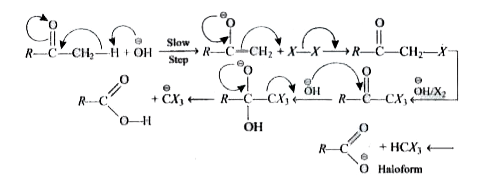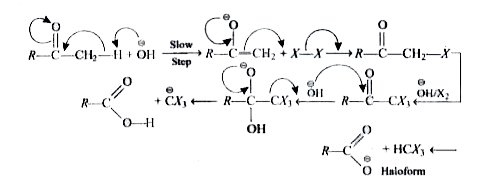Compound can be prepared by the reaction of _______ .
phenol and benzoic acid in the presence of NaOH
phenol and benzoyl chloride in the presence of pyridine
phenol and benzoyl chloride in the presence of
phenol and benzaldehyde in the presence of palladium
The correct Answer is:B
To solve the question regarding the preparation of the compound Ph−O−C(=O)−Ph (phenyl benzoate), we can follow these steps:
Step 1: Identify the Structure
The compound Ph−O−C(=O)−Ph consists of a phenyl group (Ph) attached to an oxygen (O) which is further connected to a carbonyl group (C=O) and another phenyl group. This structure is known as phenyl benzoate.
Step 2: Determine Possible Reactions
To prepare phenyl benzoate, we need to consider the types of reactions that can form esters. One common method is the reaction between a phenol and an acyl chloride (acid chloride).
Step 3: Analyze the Given Options
1. Option 1: Phenol and Benzoic Acid
- This reaction cannot proceed because benzoic acid cannot act as an electrophile in this context.
2. Option 2: Phenol and Benzoyl Chloride
- This is a viable option. Phenol can act as a nucleophile, and benzoyl chloride can provide the electrophile needed for the reaction. The reaction would yield phenyl benzoate.
3. Option 3: Involves ZnCl2
- This option is incorrect as it does not provide the necessary reactants to form phenyl benzoate.
4. Option 4: Phenol and Benzaldehyde
- This option is also incorrect because benzaldehyde cannot provide a suitable electrophile for the nucleophilic attack by phenol.
Step 4: Conclusion
The correct answer is Option 2: Phenol and Benzoyl Chloride in the presence of a base like pyridine, which facilitates the reaction by deprotonating phenol to form a more reactive nucleophile.
Final Answer
Compound Ph−O−C(=O)−Ph can be prepared by the reaction of Phenol and Benzoyl Chloride.
---
The compound Ph−O−C(=O)−Ph consists of a phenyl group (Ph) attached to an oxygen (O) which is further connected to a carbonyl group (C=O) and another phenyl group. This structure is known as phenyl benzoate.
To prepare phenyl benzoate, we need to consider the types of reactions that can form esters. One common method is the reaction between a phenol and an acyl chloride (acid chloride).
1. Option 1: Phenol and Benzoic Acid
- This reaction cannot proceed because benzoic acid cannot act as an electrophile in this context.
2. Option 2: Phenol and Benzoyl Chloride
- This is a viable option. Phenol can act as a nucleophile, and benzoyl chloride can provide the electrophile needed for the reaction. The reaction would yield phenyl benzoate.
- This option is incorrect as it does not provide the necessary reactants to form phenyl benzoate.
- This option is also incorrect because benzaldehyde cannot provide a suitable electrophile for the nucleophilic attack by phenol.
The correct answer is Option 2: Phenol and Benzoyl Chloride in the presence of a base like pyridine, which facilitates the reaction by deprotonating phenol to form a more reactive nucleophile.
Compound Ph−O−C(=O)−Ph can be prepared by the reaction of Phenol and Benzoyl Chloride.
Topper's Solved these Questions
- BOOK - NCERT FINGERTPS ENGLISHCHAPTER - ALDEHYDES, KETONES AND CARBOXYLIC ACIDSEXERCISE - ASSERTION & REASON15videos
ALDEHYDES, KETONES AND CARBOXYLIC ACIDS
- BOOK - NCERT FINGERTPS ENGLISHCHAPTER - ALDEHYDES, KETONES AND CARBOXYLIC ACIDSEXERCISE - Nomenclature And Structure Of Carbonyl Group3videos
ALDEHYDES, KETONES AND CARBOXYLIC ACIDS
- BOOK - NCERT FINGERTPS ENGLISHCHAPTER - ALDEHYDES, KETONES AND CARBOXYLIC ACIDSEXERCISE - MCQs(CHEMICAL REACTIONS )18videos
ALDEHYDES, KETONES AND CARBOXYLIC ACIDS
- BOOK - NCERT FINGERTPS ENGLISHCHAPTER - ALCOHOLS,PHENOLS AND ETHERSEXERCISE - Assertion And Reason14videos
ALCOHOLS,PHENOLS AND ETHERS
- BOOK - NCERT FINGERTPS ENGLISHCHAPTER - AMINES EXERCISE - ASSERTION & REASON CORNER14videos
AMINES
Similar Questions
Knowledge Check
- Question 1 - Select One or More
Mixture of Ph−O∣∣C−H and HCHO is treated with NaOH then Cannizzaro reaction involves
Areduction of HCHOBoxidation of HCHOCreduction of PhCHODoxidation of PhCHO - Question 2 - Select One
Compound having −O∣∣C−CH3 group reacts rapidly with halogen in presence of a base to form haloform. The reaction is known as haloform.
R−O∣∣C−CH3X2+ϴOH−−−−→R−O∣∣C−ϴO+CHX3
Mechanism

Consider the following reactions:
Reaction I →Ph−O∣∣C−CH3Cl2,ϴOH−−−−→Ph−O∣∣C−ϴO+CHCl3
Reaction II →Ph−O∣∣C−CD3−Cl2,ϴOH−−−−→Ph−O∣∣C−ϴO+CDCl3
Which of the following is correct comparison of the rate of reaction I and II?ArI>rIIBrI>rIICrI=rIIDCannot be determined - Question 3 - Select One or More
Compound having −O∣∣C−CH3 group reacts rapidly with halogen in presence of a base to form haloform. The reaction is known as haloform.
R−O∣∣C−CH3X2+ϴOH−−−−→R−O∣∣C−ϴO+CHX3
Mechanism


Which of the following is correct comparisonof rate of haloform reaction with various halogens?ArCl2>rBr2>rI2BrI2>rBr2>rCl2CrCl2=rBr2=rI2DrBr2>rCl2>rI2
Ph−O∣∣C−CH3+CH2=O(excess)OHΘ−−→Ph−O∣∣C−C(CH2OH)3
In the above reaction how times of aldol reaction takes place ?View SolutionPh−CHO+Ph−CHONa2[Fe(CO)4]−−−−−−−−−−→Ph−O||C−OCH2−Ph . This reaction is known as :
View SolutionCompound having −O∣∣C−CH3 group reacts rapidly with halogen in presence of a base to form haloform. The reaction is known as haloform.
R−O∣∣C−CH3X2+ϴOH−−−−→R−O∣∣C−ϴO+CHX3
Mechanism

Which of the following will yield iodoform on reaction with I2+NaOH?View SolutionPh−CH=CH−O∣∣C−OH
The IUPAC name is :View SolutionCH3−O∣∣C−H and Ph−O∣∣C−H can be differentiated by :
View Solution

